|
|
Black holes were theorized more than 200 years ago, and later
were predicted by Einstein's theory of general relativity.
The discovery of active galaxies forced astronomers to think that
monstrous black holes really do exist and are the "engines" at the
heart of these fireworks. The gushers of light and other radiation
from such objects could not be explained by starlight alone.
By definition, a black hole is very hard to find. It is a celestial
object that squeezes a lot of material into a very small space. The
resulting gravitational pull is so intense that anything passing
nearby, even light, is trapped forever.
Like a ghost in a mystery story, a black hole's presence must be
inferred by the effects on its surroundings. Its powerful gravity
will influence the motion of neighboring stars. The closer the stars
are to the black hole, the faster they should be
moving, just as orbiting planets move faster the closer they are to
the Sun. If no black hole is present,
the speed of the stars should slow toward the hub of a galaxy,
because most of the gravity influencing their motion would come from
the other stars in the galaxy.
Once the speed of the entrapped material is measured, astronomers
can calculate the mass of the black hole using the
simple laws of gravity, just as the orbital speed of the Moon can be
used to calculate Earth's mass. If it turns out that there is far
more mass present than there are stars, the matter must be tucked
away in something that is invisible and compact.
Similar observations have been made with ground-based telescopes
since the mid-1980s; but having to look through the Earth's
turbulent atmosphere severely limits the accuracy of such telescopes
for detecting and measuring a large, central mass. While the
ground-based data give ambiguous lower limits to the central mass,
NASA Hubble Space Telescope observations are decisive
for accurately measuring the mass and ruling out all other possible
explanations.
 The
first black hole confirmation was nailed down when the space
telescope uncovered a spiral disk of gas swirling around the hub of
the giant elliptical galaxy M87 (called Virgo A,
located in the Constellation Virgo). The
first black hole confirmation was nailed down when the space
telescope uncovered a spiral disk of gas swirling around the hub of
the giant elliptical galaxy M87 (called Virgo A,
located in the Constellation Virgo).
 The
shape alone suggested that the material was caught in a
gravitational whirlpool. Using Hubble's spectrographs, astronomers
were able to measure the velocity of the gas by a method known as
Doppler shift. As the disk spins like a carousel, one side of it
approaches us and is blueshifted, while the other side rotates away
and is redshifted. The
shape alone suggested that the material was caught in a
gravitational whirlpool. Using Hubble's spectrographs, astronomers
were able to measure the velocity of the gas by a method known as
Doppler shift. As the disk spins like a carousel, one side of it
approaches us and is blueshifted, while the other side rotates away
and is redshifted.
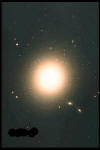 Astronomers
concluded that the gas is whirling at more than a million miles an
hour. This information can be used to calculate how much mass is
packed into the core of M87. It turns out that the
mass of two billion Suns is compressed into a region of space no
bigger than our solar system. Hubble has made similar observations
in two other elliptical galaxies, NGC 4261 and NGC 3115.
These monstrous black holes weigh in, respectively, at 200 million
solar masses and two billion solar masses. Astronomers
concluded that the gas is whirling at more than a million miles an
hour. This information can be used to calculate how much mass is
packed into the core of M87. It turns out that the
mass of two billion Suns is compressed into a region of space no
bigger than our solar system. Hubble has made similar observations
in two other elliptical galaxies, NGC 4261 and NGC 3115.
These monstrous black holes weigh in, respectively, at 200 million
solar masses and two billion solar masses.
|

The Giant
Elliptical Galaxy NGC 4261 |

NGC
4261:Trail of Black Holes and Neutron Stars Points to
Ancient Collision |
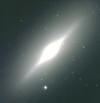
bright
lenticular galaxy, NGC 3115 |

NGC 3115 |
Surveys of galaxy nuclei
in both active and quiescent galaxies suggest black holes are
common
to virtually all galaxies. The mystery is how the black holes formed
in the first place. The abundance of quasars in the early universe,
objects at the hearts of galaxies that pour out a torrent of
radiation, suggest that monstrous black holes must have formed very
early, though it is still not known how this happened.
Hubble images of quasars show that they reside in a variety of
galaxies, both spiral and elliptical. Many but not all of the quasar
host galaxies, are engaged in a collision or interaction with other
bypassing galaxies. The infall of gas resulting from such collisions
fuels the monster black holes.

|

|
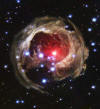 |
Large Image
Video
 |
 |
Large Image
Video
 |
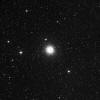 |
Large Image
Video
 |
|
This image
resembling Vincent van Gogh's painting, "Starry Night," is
Hubble's latest view of an expanding halo of light around a
distant star,
named V838 Monocerotis (V838 Mon). This Hubble image was
obtained with
the Advanced Camera for Surveys on February 8, 2004. The
illumination
of interstellar dust comes from the red supergiant star at the
middle
of the image, which gave off a flashbulb-like pulse of light two
years
ago. V838 Mon is located about 20,000 light-years away from
Earth in
the direction of the constellation Monoceros, placing the star
at the outer edge of our Milky Way galaxy. |
The Outburst
This animation shows the sudden brightening of the star V838 Mon
as it happened on Jan 2002. The star got much brighter because
it expanded to a red super giant. In the foreground is a blue
companion star.
|
(Photo: Artist'
Concept)
Black Hole
in a Globular Cluster
Medium-size black
holes actually do exist, according to the latest findings from
NASA's Hubble Space Telescope, but scientists had to look
in some unexpected places to find them.
The previously undiscovered black holes provide an important
link that sheds light on the way black holes grow. Even more
odd, these new black holes were found in the cores of
glittering, "beehive" swarms of stars - called globular star
clusters - that orbit our Milky Way and other galaxies.
|
|
 |
Large Image
Video
 |
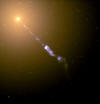 |
Large Image |
 |
Large Image |
|
'Death Spiral'
Around a Black Hole Yields Tantalizing Evidence of an Event Horizon
The Hubble telescope may have, for the first time, provided direct
evidence for
the existence of black holes by observing how matter disappears when
it falls
beyond the "event horizon," the boundary between a black hole and
the outside
universe. Astronomers found their evidence by watching the fading
and disappearance
of pulses of ultraviolet light from clumps of hot gas swirling
around a massive,
compact object called Cygnus XR-1. This activity suggests that the
hot gas fell
into a black hole. |
A Cosmic Searchlight
Streaming out from the center of the galaxy M87 like a cosmic
searchlight is one of nature's most amazing phenomena, a
black-hole-powered jet of electrons and other sub-atomic particles
traveling at nearly the speed
of light. In this Hubble telescope
image, the blue jet contrasts with the yellow glow from the combined
light of billions of unseen stars and the yellow, point-like
clusters of stars that make up this galaxy. Lying at the center of
M87, the monstrous black hole has swallowed up matter equal to 2
billion times our Sun's mass. M87 is 50 million
light-years from Earth. |
Hubble Discovers Black Holes in
Unexpected Places
Medium-size black holes actually do exist, according to the latest
findings from NASA's Hubble Space Telescope, but scientists had to
look in some unexpected places to find them.
The previously undiscovered black holes provide an important link
that sheds light on the way black holes grow. Even more odd, these
new black holes were found in the cores of glittering, "beehive"
swarms of stars - called globular star clusters - that orbit our
Milky Way and other galaxies.
The new findings promise a better understanding of how galaxies and
globular clusters first formed billions of years ago. |

|